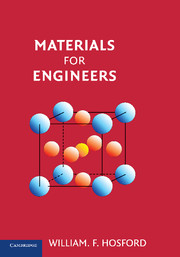Book contents
- Frontmatter
- Contents
- Preface
- 1 Introduction
- 2 Phases
- 3 Diffusion
- 4 Mechanical Behavior
- 5 Mechanical Failure
- 6 Annealing
- 7 Iron and Steel
- 8 Nonferrous Metals
- 9 Casting and Welding
- 10 Solid Shaping
- 11 Polymers
- 12 Polymer Processing
- 13 Glasses
- 14 Crystalline Ceramics
- 15 Powder Processing
- 16 Pottery and Concrete
- 17 Composites
- 18 Carbon
- 19 Fibers, Foams, and Porous Materials
- 20 Electrical Properties
- 21 Optical and Thermal Properties
- 22 Magnetic Materials
- 23 Corrosion
- 24 Modern Manufacturing Techniques, Surface Treatments, and Recycling
- APPENDIX 1 Wood
- APPENDIX 2 Miller Indices for Planes and Directions
- APPENDIX 3 X-ray Diffraction
- APPENDIX 4 Surfaces
- APPENDIX 5 Dislocations
- APPENDIX 6 Avrami Kinetics
- APPENDIX 7 Organic Chemistry
- APPENDIX 8 Average Molecular Weight
- APPENDIX 9 Bond Geometry in Compounds
- APPENDIX 10 Weibull Analysis
- Index
- Conversions
24 - Modern Manufacturing Techniques, Surface Treatments, and Recycling
Published online by Cambridge University Press: 05 June 2012
- Frontmatter
- Contents
- Preface
- 1 Introduction
- 2 Phases
- 3 Diffusion
- 4 Mechanical Behavior
- 5 Mechanical Failure
- 6 Annealing
- 7 Iron and Steel
- 8 Nonferrous Metals
- 9 Casting and Welding
- 10 Solid Shaping
- 11 Polymers
- 12 Polymer Processing
- 13 Glasses
- 14 Crystalline Ceramics
- 15 Powder Processing
- 16 Pottery and Concrete
- 17 Composites
- 18 Carbon
- 19 Fibers, Foams, and Porous Materials
- 20 Electrical Properties
- 21 Optical and Thermal Properties
- 22 Magnetic Materials
- 23 Corrosion
- 24 Modern Manufacturing Techniques, Surface Treatments, and Recycling
- APPENDIX 1 Wood
- APPENDIX 2 Miller Indices for Planes and Directions
- APPENDIX 3 X-ray Diffraction
- APPENDIX 4 Surfaces
- APPENDIX 5 Dislocations
- APPENDIX 6 Avrami Kinetics
- APPENDIX 7 Organic Chemistry
- APPENDIX 8 Average Molecular Weight
- APPENDIX 9 Bond Geometry in Compounds
- APPENDIX 10 Weibull Analysis
- Index
- Conversions
Summary
Two-dimensional Photolithography
The intricate circuits formed on semiconductor chips are patterned by photolithography. A photosensitive material (photoresist) is applied to a semiconductor surface and baked at a low temperature. The surface is then exposed to intense ultraviolet light. The exposed regions of the photoresist become soluble in a developer and are removed. The surface is then baked at a somewhat higher temperature to harden the remaining photoresist. The exposed regions are then acid etched.
The etched regions may then be treated differently from the rest of the surface. They may be doped by exposure to plasma containing n- or p-type impurities, or they may be plated to form conducting circuits. Integrated circuits are composed of many overlapping layers (Figure 24.1), each defined by photolithography. Dopants are diffused into the substrate, and additional ions are implanted into some layers. Metal and polycrystalline silicon are deposited on others to form conductive circuits.
Transistors can be formed where there are n-p-n or p-n-p diffusion layers. Resistors are formed by meandering stripes of varying lengths. Capacitors are formed by parallel conductors separated by insulating material. The most common integrated circuits and those with the highest density are random access memories.
Photo-stereolithography
Three-dimensional parts can be made by photo-stereolithography using a liquid that polymerizes on exposure to ultraviolet light. A substrate platform is lowered into a bath and a desired portion of the surface of the liquid is exposed to a beam of ultraviolet light, causing it to polymerize.
- Type
- Chapter
- Information
- Materials for Engineers , pp. 231 - 238Publisher: Cambridge University PressPrint publication year: 2008



